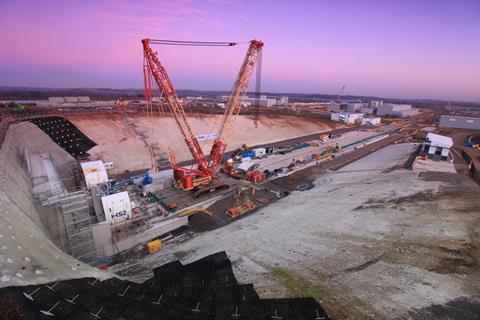Warning over pressure on costs and margins as booming housebuilding and commercial markets fan increase in workloads
Construction output has hit a 24 year high driven by a booming housing market and a recovering commercial sector, the latest monthly figures from the IHS Markit/CIPS survey have said.
But the latest data underlined the problems many are now facing over materials and labour shortages with the problems sending business confidence in construction to a six month low.

The CIPS monthly index for June stood at 66.3 – the highest figure since June 1997 and up from the 64.2 recorded in May.
The survey of purchasing managers said housebuilding increased at the fastest pace since November 2003 to record a score of 68.2 while commercial saw the pace of recovery hit its highest level since March 1998 with a score of 66.9. But the speed of activity in civil engineering slowed to a three month low with a score of 60.7.
This morning’s figures mean that total new orders have been above the 50 no-charge mark in each of the past 13 months, with the recovery beginning in May last year following a catastrophic April 2020 which saw output plummet as the restrictions caused by the first national lockdown to deal with the covid-19 pandemic began to bite.
But concerns remain about access to materials with last month being recorded as the worst ever for supplier delays since the survey began in April 1997.
Shipping and road haulage problems have been blamed for the delays with materials in short supply including cement, plaster, steel, timber and roof tiles.
KPMG head of infrastructure, building and construction Jan Crosby said: “These shortages and price rises are causing builds to be more expensive overall and making it difficult for the sector to plan for unexpected costs on projects.”
The survey confirmed materials price hikes are starting to take effect with subcontractors now factoring in the rises, as well as problems in getting hold of labour, which meant the prices they charged jumped by the steepest amount since records began.
All this was denting confidence, IHS Markit economic director Tim Moore said, who added: “Escalating cost pressures and concerns about labour availability appear to have constrained business optimism at some building firms. The degree of positive sentiment towards the year ahead growth outlook remained high but eased to its lowest since the start of 2021.”
Scape boss Mark Robinson said materials shortages would pass but the industry needed to address the problem of finding enough workers to carry out the government’s promised building boom. “The government must ensure specific trades are included in the shortage occupation list to alleviate pressure,” he added.
The pressure on materials and labour resources will only get worse over the rest of the summer, the director of Lloyds Bank’s infrastructure and construction team predicted.
Max Jones added: “Pent-up demand for work on commercial projects in major cities, infrastructure in the regions and housing developments across the country threaten a battle for materials that many report are in short supply. This will create pinch points and potentially push up prices, eroding margins.
“HS2, which will be a major driver of work in the second half of the year, will expose some of the industry’s weaknesses. With the project attracting talent and skills from all over the country, it risks exacerbating the labour shortages contractors are already grappling with.”




























No comments yet